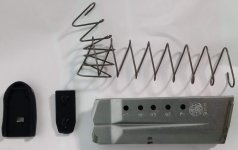It can be quite a practical problem.
Given that autopistols are supposed to be used with a functional magazine installed, it's difficult to see what the practical problem is with having a functional magazine be part of the normal ejection process. That's why I made the comment that I did.
Bottom line. Pistol with properly fitted extractor will eject (no stoppage) with or without a magazine.
The fact is that the magazine can, and does play a part in the normal ejection process in some designs. I don't know of any designs where the magazine being non-functional or missing is guaranteed to cause a stoppage due to ejection problems, but then again, I haven't claimed otherwise. But magazines can and do have an effect on ejection of spent brass because the next round in the magazine (and/or the follower in some designs) pushes upward on the brass as it is extracted from the chamber. That is why I responded to the comment that: "Ejection of spent brass shouldn't have much to do with magazine."
Whether or not we think it should, it is often the case that ejection of spent brass does have something to do with the magazine.
Checking the extraction and ejection function with a functional magazine is a very good idea for a pistol intended for self-defense, and I would recommend the same thing. However, it's a bit of a stretch to assume that the first ejection malfunction experienced just happened to occur simultaneous with an obvious magazine problem and that there's no connection between the two. That would be true even if there were no known connection between magazine issues and ejection. However, there is a known connection and therefore it's even more of a stretch.
Although I'm not sure why you would assume I'm making this up, and I can't imagine what you think my motive would be for doing such a thing, if you refuse to accept my word on the issue, here's some reading material from other sources.
http://smith-wessonforum.com/smith-...can-bad-magazine-cause-ejection-problems.html
"I have 4 mags for my rifle. One mag consistently has 4-6 fte's with good ammo."
https://www.bullseyepistol.com/malfunction.htm
"The magazine can cause a variety of manfunctions including feeding problems and even failures to eject."
https://www.thektog.org/threads/failure-to-extract-causes-and-cures.245367/
"Another cause of failure to extract/eject, although perhaps counter-intuitive, is a bad magazine/weak mag spring. This is so because a weak mag spring can allow a roiund to "release" from the mag early as the bolt is extracting the fired case. Then, as the front of the new cartridge rises, it can strike against the extracted case, preventing the case from ejecting and instead, the case is then re-chambered, with the new cartridge then jamming against the re-chambered, fired case. "
https://forums.brianenos.com/topic/198729-xd-failure-to-eject/
"Just today though, the XD started having failure to ejects on about 70% of rounds shot like this. However, it never had a FTE with a magazine in. I shot multiple 5 and 10 shot strings with a magazine inserted, probably 100 rounds total, and it never experienced a FTE. However, on the 50 or so shots I shot without a magazine in, it would FTE on about 70% of them. "
https://www.glocktalk.com/threads/glock-19-failure-to-eject.1611222/
"I have a new Glock 19 Gen3 with around 600 rounds through it. I use factory G17 and G19 magazines without issue. I bought a couple 17 round PMAGs from Midway last month, and I've had two failure to ejects when using one of these magazines. "
https://lockedback.com/stove-pipe-malfunction-clear/
"Stovepipes can be caused by a number of issues – such as a bad magazine..."

